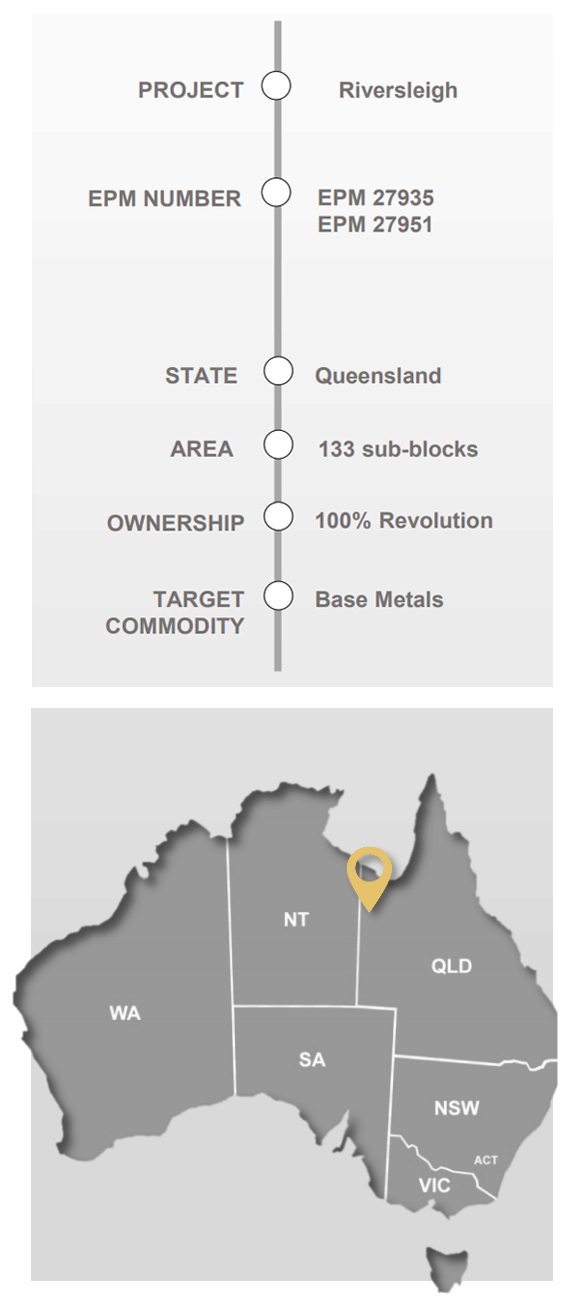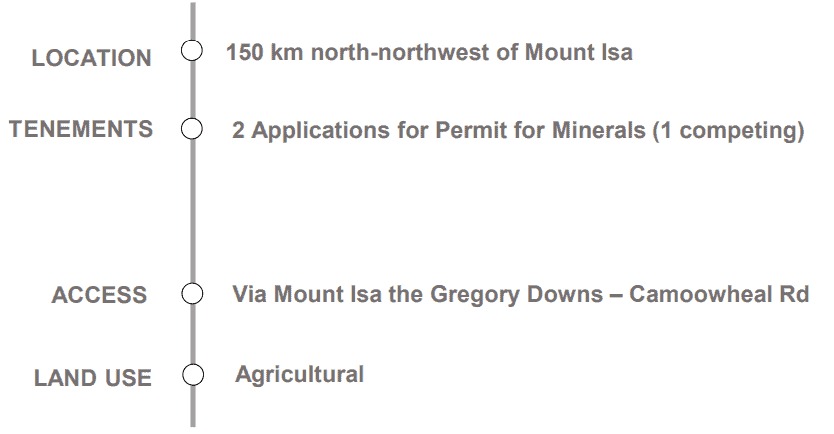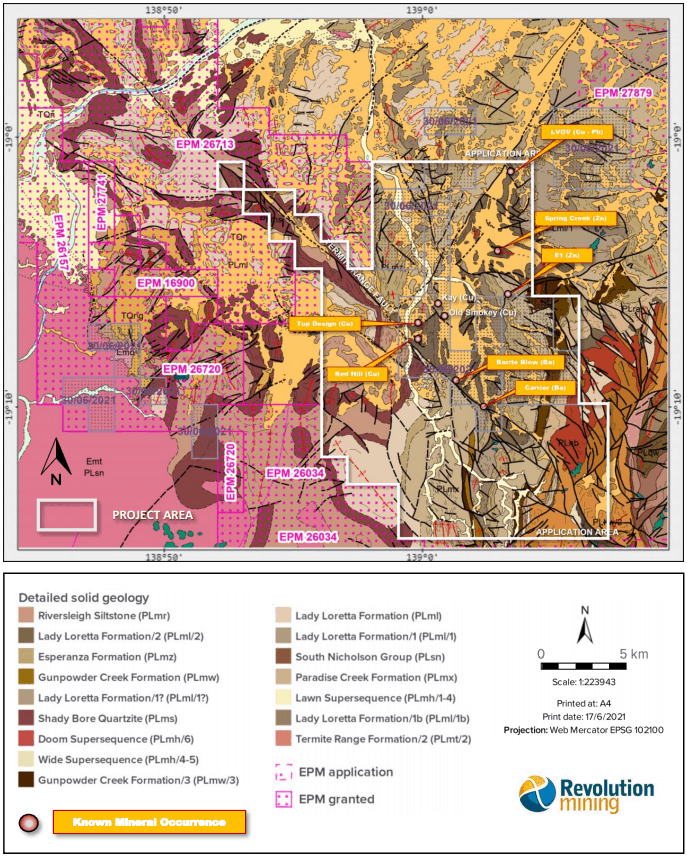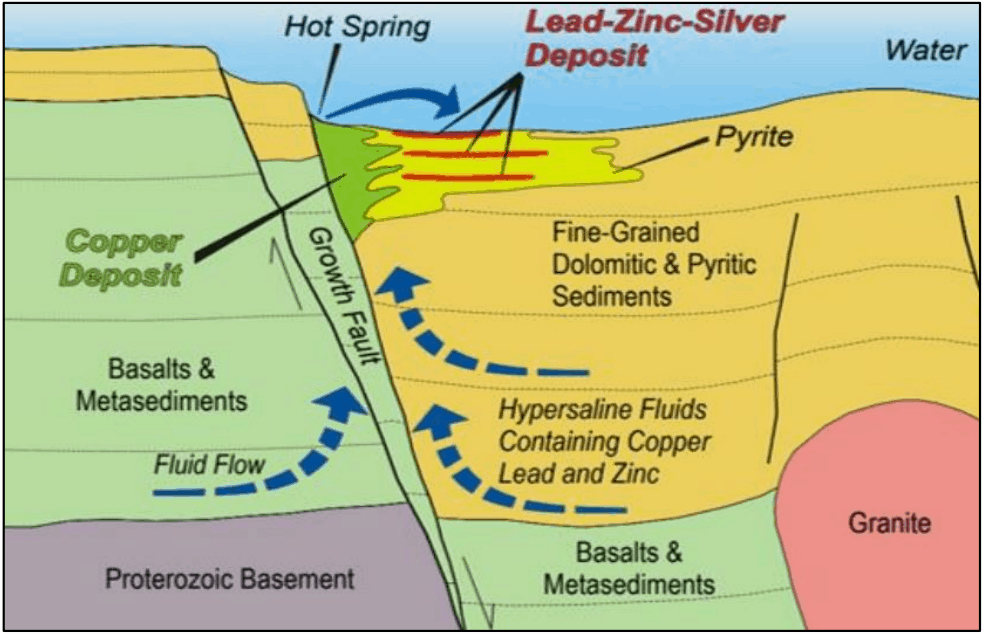Overview
The base metal region of Mt Isa and Cloncurry are synonymous with world-class copper and zinc deposits and the mineral field is a sought-after jurisdiction for base-metal style exploration which is well supported by existing infrastructure.
Revolution has secured a large tenement package (~1,200 square kilometers) east of Century base metal deposit covering the margin of the Western Succession on the Lawn Hill Platform.
The project is prospective for SEDEX and epigenetic copper discoveries
Project Summary

Project Highlights
GEOLOGY
TARGETS
LOGISTICS
Project Location

Project Logistics

Project Tenement Summary
| LICENCE NUMBER |
NAME | STATUS | TERM | APPLICATION DATE |
| EPM 27935 | Riversleigh | Application | 5 Years | 1 October 2020 |
| EPM 27951 | Police Creek | Application | 5 Years | 1 October 2020 |
Project Geology

Regional geology and proximity to Century base metal deposit

Project Geology and known mineral prospects
Geological Rationale
The Riversleigh project area covers highly prospective units of the Palaeo- to Mesoproterozoic McNamara Group (time equivalent of the Fickling, Mount Isa and McArthur Groups) ranging from the Lady Loretta Formation to the Lawn Hill Formation.
The Lawn Hill Platform is host to several styles of base metal Copper-Lead-Zinc-Silver (Cu-Pb-Zn-Ag) mineralisation including:
Exploration Summary
In the early 1980’s Shell Australia carried out mapping, sampling and dipole-dipole IP surveying within the project area. The broader district-scale exploration program was called the Western Basin Survey and covered a large portion of the McNamara Group. Exploration commenced with acquisition of an airborne INPUT/radiometrics‐magnetics survey. Anomalous responses from this survey were tested with IP traversing and coincident mapping and geochemical sampling. The company also looked at the old copper workings (Top Design,Old Smoky,Kay,Why) and found that they occurred along faulted lithological contacts often on or near the hinge zones on anticlinal flexures. A number of the IP traverses were undertaken across a number of EM anomalies.
Shell drilled a number of diamond holes to test the lead‐zinc mineralisation outlined by soil sampling over a 15 kilometres of strike in the Lady Loretta Formation. CRD1‐5 drill tested the lead‐zinc mineralised horizon. Unfortunately the mineralisation whilst widespread was in each hole at only anomalous levels. CRP1‐12 were drilled to the south of the Spring Creek Fault but also failed to intersect economic lead‐zinc grades. Shell tested the copper mineralisation associated with the Top Design and Kay prospects. CRD6 intersected silica‐dolomite alteration (similar to Mt Isa-style) in the Paradise Creek Formation. The hole intersected associated copper mineralisation with a best intercept of 6.5m @ 2.6% Cu. A further three holes (CRD7‐9) were drilled to test for down dip extensions to the CRD6 intercept. Whilst the holes intercepted wider zones of silica‐dolomite alteration copper grades decreased markedly albeit over very broad intervals (CRD9 0‐242m @ 0.04% Cu).
In the late 1980’s Hunter Resources Ltd carried out a program of detailed structural mapping and sampling, searching for structural analogues of the Mount Isa Cu orebody. An RC/diamond drilling program comprising 10 holes were completed to a maximum depth of 132m into the Cu-anomalous White Ant Fault Zone, several small weakly Cu mineralised pods (max. 0.4% Cu) were intersected.
Between 1991 and 1999 Aberfoyle Resources followed up on the earlier exploration results conducting a major airborne GEOTEM survey. A number of EM anomalies were identified and two priority targets were followed up with 2 drill holes testing conductive anomalies for SEDEX Zn mineralisation and Isastyle Cu Mineralised silica-dolomite. No significant base metal mineralisation was encountered. It was concluded that the anomalies were caused by carbonaceous, pyritic shales. Further soil sampling identified a zone of anomalous zinc (1km x 200m @>200 ppm Zn) located near the Termite Range fault. The anomaly was not drill tested after the company noted the absence of lead and decided that the source of metals was more likely a zinc mineralised shear.
Base Metal Mineralisation
The tenement is located between major lead-zinc-silver ‘sedex’ style deposits at Lady Loretta (70 kms to the south) and Century (60 km to the northwest). A review of past exploration indicates prospective McNamara Group sediments in the area are analogous to those hosting the Century and Lady Loretta deposits.
Proximity to the Termite Range Fault and also cross-cutting structures is also considered very encouraging. Widespread zinc-lead anomalism and the presence of lead-zinc mineralised beds is evidence that the right systems were in process in the tenement area.
Minor barite occurrences along the Termite Range Fault offer additional evidence of the fertility of this structure and genetic links to VMS systems. Barite occurs as lenses and veins in association with copper, lead and zinc mineralisation at the Barite Blow and Carrier prospects in the Lady Loretta and Paradise Creek Formations, close to the Termite Range Fault. Smaller barite veins up to 1m wide are common along the fault zone over a strike length of 2km. Mineralisation occurs in a massive, ferruginous brecciated chert with historical sampling returning 32.7% BaSO4, with strong base metal geochemistry (up to 210 ppm Cu, 0.37% Pb, 2.8% Zn; Marlow, 1975). Could the barite occurrences be the more distal parts of a broader VMS system.
Available Exploration Data

Deposit Model

The model indicates, for example, how both stratiform lead-zinc and pyritic shale expand the target zone for the discovery of
Mount Isa type copper deposits and the importanceof basic rocks to copper deposit formation
Target Summary
Most of the historical exploration has targeted ‘low hanging fruit’ yet many of the geochemical anomalies have been dismissed on the basis of lack of magnetic or EM anomalies. This is despite the fact that the Century deposit was drilled on the basis of a geochemical anomaly that had no coincident magnetic or electromatic anomaly profiles across the geochemical anomaly. In addition, many prospects received further exploration focus on the back of EM anomalies, that were later proven to represent particular conductive lithologies, and potentially not the best measure of prospectivity.
Once the 3D geological is built, a thorough review of specific geophysical techniques effectiveness to define the type mineralisation targets is required, including a ‘fresh-eyes’ approach to the existing exploration data and how prospect ranking has been undertaken to potentially ‘resurrect’ existing geochemical targets.
Modern advances in geophysical data acquisition and process then needs to address which of the existing data is now relatively redundant and needs to be re-acquired. This process should be done to ‘strip back’ the exploration data to that which is reliable to make decisions on prospectivity and which prospects to progress and how.
Revolution suspects an exploration target generation program will require seismic, IP and gravity as the best calibration of datasets.
The area as an exploration project has merit. It ticks many of the fundamental geological attributes to host the defined mineralisation styles. It has evidence of the ‘right-style of mineralisation (geochemically and alteration) and enough previous exploration conducted to make meaningful inroads onto new targets with a detailed desktop targeting study. Most of this meaningful exploration was done from the 70’s through the 90’s and has had relatively little on-ground exploration since. There is certainly an opportunity to apply modern geoscience techniques to review the area with ‘fresh eyes’ and with the benefit of advances in understanding of these deposits from research.
A significant desktop target ranking exercise is required to prioritize and focus field reconnaissance.

Overview
The base metal region of Mt Isa and Cloncurry are synonymous with world-class copper and zinc deposits and the mineral field is a sought-after jurisdiction for base-metal style exploration which is well supported by existing infrastructure.
Revolution has secured a large tenement package (~1,200 square kilometers) east of Century base metal deposit covering the margin of the Western Succession on the Lawn Hill Platform.
The project is prospective for SEDEX and epigenetic copper discoveries
Project Summary

Project Highlights
GEOLOGY
TARGETS
LOGISTICS
Project Location

Project Logistics

Project Tenement Summary
| LICENCE NUMBER |
NAME | STATUS | TERM | APPLICATION DATE |
| EPM 27935 | Riversleigh | Application | 5 Years | 1 October 2020 |
| EPM 27951 | Police Creek | Application | 5 Years | 1 October 2020 |
Project Geology

Regional geology and proximity to Century base metal deposit

Project Geology and known mineral prospects
Geological Rationale
The Riversleigh project area covers highly prospective units of the Palaeo- to Mesoproterozoic McNamara Group (time equivalent of the Fickling, Mount Isa and McArthur Groups) ranging from the Lady Loretta Formation to the Lawn Hill Formation.
The Lawn Hill Platform is host to several styles of base metal Copper-Lead-Zinc-Silver (Cu-Pb-Zn-Ag) mineralisation including:
Exploration Summary
In the early 1980’s Shell Australia carried out mapping, sampling and dipole-dipole IP surveying within the project area. The broader district-scale exploration program was called the Western Basin Survey and covered a large portion of the McNamara Group. Exploration commenced with acquisition of an airborne INPUT/radiometrics‐magnetics survey. Anomalous responses from this survey were tested with IP traversing and coincident mapping and geochemical sampling. The company also looked at the old copper workings (Top Design,Old Smoky,Kay,Why) and found that they occurred along faulted lithological contacts often on or near the hinge zones on anticlinal flexures. A number of the IP traverses were undertaken across a number of EM anomalies.
Shell drilled a number of diamond holes to test the lead‐zinc mineralisation outlined by soil sampling over a 15 kilometres of strike in the Lady Loretta Formation. CRD1‐5 drill tested the lead‐zinc mineralised horizon. Unfortunately the mineralisation whilst widespread was in each hole at only anomalous levels. CRP1‐12 were drilled to the south of the Spring Creek Fault but also failed to intersect economic lead‐zinc grades. Shell tested the copper mineralisation associated with the Top Design and Kay prospects. CRD6 intersected silica‐dolomite alteration (similar to Mt Isa-style) in the Paradise Creek Formation. The hole intersected associated copper mineralisation with a best intercept of 6.5m @ 2.6% Cu. A further three holes (CRD7‐9) were drilled to test for down dip extensions to the CRD6 intercept. Whilst the holes intercepted wider zones of silica‐dolomite alteration copper grades decreased markedly albeit over very broad intervals (CRD9 0‐242m @ 0.04% Cu).
In the late 1980’s Hunter Resources Ltd carried out a program of detailed structural mapping and sampling, searching for structural analogues of the Mount Isa Cu orebody. An RC/diamond drilling program comprising 10 holes were completed to a maximum depth of 132m into the Cu-anomalous White Ant Fault Zone, several small weakly Cu mineralised pods (max. 0.4% Cu) were intersected.
Between 1991 and 1999 Aberfoyle Resources followed up on the earlier exploration results conducting a major airborne GEOTEM survey. A number of EM anomalies were identified and two priority targets were followed up with 2 drill holes testing conductive anomalies for SEDEX Zn mineralisation and Isastyle Cu Mineralised silica-dolomite. No significant base metal mineralisation was encountered. It was concluded that the anomalies were caused by carbonaceous, pyritic shales. Further soil sampling identified a zone of anomalous zinc (1km x 200m @>200 ppm Zn) located near the Termite Range fault. The anomaly was not drill tested after the company noted the absence of lead and decided that the source of metals was more likely a zinc mineralised shear.
Base Metal Mineralisation
The tenement is located between major lead-zinc-silver ‘sedex’ style deposits at Lady Loretta (70 kms to the south) and Century (60 km to the northwest). A review of past exploration indicates prospective McNamara Group sediments in the area are analogous to those hosting the Century and Lady Loretta deposits.
Proximity to the Termite Range Fault and also cross-cutting structures is also considered very encouraging. Widespread zinc-lead anomalism and the presence of lead-zinc mineralised beds is evidence that the right systems were in process in the tenement area.
Minor barite occurrences along the Termite Range Fault offer additional evidence of the fertility of this structure and genetic links to VMS systems. Barite occurs as lenses and veins in association with copper, lead and zinc mineralisation at the Barite Blow and Carrier prospects in the Lady Loretta and Paradise Creek Formations, close to the Termite Range Fault. Smaller barite veins up to 1m wide are common along the fault zone over a strike length of 2km. Mineralisation occurs in a massive, ferruginous brecciated chert with historical sampling returning 32.7% BaSO4, with strong base metal geochemistry (up to 210 ppm Cu, 0.37% Pb, 2.8% Zn; Marlow, 1975). Could the barite occurrences be the more distal parts of a broader VMS system.
Available Exploration Data

Deposit Model

The model indicates, for example, how both stratiform lead-zinc and pyritic shale expand the target zone for the discovery of
Mount Isa type copper deposits and the importanceof basic rocks to copper deposit formation
Target Summary
Most of the historical exploration has targeted ‘low hanging fruit’ yet many of the geochemical anomalies have been dismissed on the basis of lack of magnetic or EM anomalies. This is despite the fact that the Century deposit was drilled on the basis of a geochemical anomaly that had no coincident magnetic or electromatic anomaly profiles across the geochemical anomaly. In addition, many prospects received further exploration focus on the back of EM anomalies, that were later proven to represent particular conductive lithologies, and potentially not the best measure of prospectivity.
Once the 3D geological is built, a thorough review of specific geophysical techniques effectiveness to define the type mineralisation targets is required, including a ‘fresh-eyes’ approach to the existing exploration data and how prospect ranking has been undertaken to potentially ‘resurrect’ existing geochemical targets.
Modern advances in geophysical data acquisition and process then needs to address which of the existing data is now relatively redundant and needs to be re-acquired. This process should be done to ‘strip back’ the exploration data to that which is reliable to make decisions on prospectivity and which prospects to progress and how.
Revolution suspects an exploration target generation program will require seismic, IP and gravity as the best calibration of datasets.
The area as an exploration project has merit. It ticks many of the fundamental geological attributes to host the defined mineralisation styles. It has evidence of the ‘right-style of mineralisation (geochemically and alteration) and enough previous exploration conducted to make meaningful inroads onto new targets with a detailed desktop targeting study. Most of this meaningful exploration was done from the 70’s through the 90’s and has had relatively little on-ground exploration since. There is certainly an opportunity to apply modern geoscience techniques to review the area with ‘fresh eyes’ and with the benefit of advances in understanding of these deposits from research.
A significant desktop target ranking exercise is required to prioritize and focus field reconnaissance.

Overview
The base metal region of Mt Isa and Cloncurry are synonymous with world-class copper and zinc deposits and the mineral field is a sought-after jurisdiction for base-metal style exploration which is well supported by existing infrastructure.
Revolution has secured a large tenement package (~1,200 square kilometers) east of Century base metal deposit covering the margin of the Western Succession on the Lawn Hill Platform.
The project is prospective for SEDEX and epigenetic copper discoveries
Project Summary

Project Highlights
GEOLOGY
TARGETS
LOGISTICS
Project Location

Project Logistics

Project Tenement Summary
| LICENCE NUMBER |
NAME | STATUS | TERM | APPLICATION DATE |
| EPM 27935 | Riversleigh | Application | 5 Years | 1 October 2020 |
| EPM 27951 | Police Creek | Application | 5 Years | 1 October 2020 |
Project Geology

Regional geology and proximity to Century base metal deposit

Project Geology and known mineral prospects
Geological Rationale
The Riversleigh project area covers highly prospective units of the Palaeo- to Mesoproterozoic McNamara Group (time equivalent of the Fickling, Mount Isa and McArthur Groups) ranging from the Lady Loretta Formation to the Lawn Hill Formation.
The Lawn Hill Platform is host to several styles of base metal Copper-Lead-Zinc-Silver (Cu-Pb-Zn-Ag) mineralisation including:
Exploration Summary
In the early 1980’s Shell Australia carried out mapping, sampling and dipole-dipole IP surveying within the project area. The broader district-scale exploration program was called the Western Basin Survey and covered a large portion of the McNamara Group. Exploration commenced with acquisition of an airborne INPUT/radiometrics‐magnetics survey. Anomalous responses from this survey were tested with IP traversing and coincident mapping and geochemical sampling. The company also looked at the old copper workings (Top Design,Old Smoky,Kay,Why) and found that they occurred along faulted lithological contacts often on or near the hinge zones on anticlinal flexures. A number of the IP traverses were undertaken across a number of EM anomalies.
Shell drilled a number of diamond holes to test the lead‐zinc mineralisation outlined by soil sampling over a 15 kilometres of strike in the Lady Loretta Formation. CRD1‐5 drill tested the lead‐zinc mineralised horizon. Unfortunately the mineralisation whilst widespread was in each hole at only anomalous levels. CRP1‐12 were drilled to the south of the Spring Creek Fault but also failed to intersect economic lead‐zinc grades. Shell tested the copper mineralisation associated with the Top Design and Kay prospects. CRD6 intersected silica‐dolomite alteration (similar to Mt Isa-style) in the Paradise Creek Formation. The hole intersected associated copper mineralisation with a best intercept of 6.5m @ 2.6% Cu. A further three holes (CRD7‐9) were drilled to test for down dip extensions to the CRD6 intercept. Whilst the holes intercepted wider zones of silica‐dolomite alteration copper grades decreased markedly albeit over very broad intervals (CRD9 0‐242m @ 0.04% Cu).
In the late 1980’s Hunter Resources Ltd carried out a program of detailed structural mapping and sampling, searching for structural analogues of the Mount Isa Cu orebody. An RC/diamond drilling program comprising 10 holes were completed to a maximum depth of 132m into the Cu-anomalous White Ant Fault Zone, several small weakly Cu mineralised pods (max. 0.4% Cu) were intersected.
Between 1991 and 1999 Aberfoyle Resources followed up on the earlier exploration results conducting a major airborne GEOTEM survey. A number of EM anomalies were identified and two priority targets were followed up with 2 drill holes testing conductive anomalies for SEDEX Zn mineralisation and Isastyle Cu Mineralised silica-dolomite. No significant base metal mineralisation was encountered. It was concluded that the anomalies were caused by carbonaceous, pyritic shales. Further soil sampling identified a zone of anomalous zinc (1km x 200m @>200 ppm Zn) located near the Termite Range fault. The anomaly was not drill tested after the company noted the absence of lead and decided that the source of metals was more likely a zinc mineralised shear.
Base Metal Mineralisation
The tenement is located between major lead-zinc-silver ‘sedex’ style deposits at Lady Loretta (70 kms to the south) and Century (60 km to the northwest). A review of past exploration indicates prospective McNamara Group sediments in the area are analogous to those hosting the Century and Lady Loretta deposits.
Proximity to the Termite Range Fault and also cross-cutting structures is also considered very encouraging. Widespread zinc-lead anomalism and the presence of lead-zinc mineralised beds is evidence that the right systems were in process in the tenement area.
Minor barite occurrences along the Termite Range Fault offer additional evidence of the fertility of this structure and genetic links to VMS systems. Barite occurs as lenses and veins in association with copper, lead and zinc mineralisation at the Barite Blow and Carrier prospects in the Lady Loretta and Paradise Creek Formations, close to the Termite Range Fault. Smaller barite veins up to 1m wide are common along the fault zone over a strike length of 2km. Mineralisation occurs in a massive, ferruginous brecciated chert with historical sampling returning 32.7% BaSO4, with strong base metal geochemistry (up to 210 ppm Cu, 0.37% Pb, 2.8% Zn; Marlow, 1975). Could the barite occurrences be the more distal parts of a broader VMS system.
Available Exploration Data

Deposit Model

The model indicates, for example, how both stratiform lead-zinc and pyritic shale expand the target zone for the discovery of
Mount Isa type copper deposits and the importanceof basic rocks to copper deposit formation
Target Summary
Most of the historical exploration has targeted ‘low hanging fruit’ yet many of the geochemical anomalies have been dismissed on the basis of lack of magnetic or EM anomalies. This is despite the fact that the Century deposit was drilled on the basis of a geochemical anomaly that had no coincident magnetic or electromatic anomaly profiles across the geochemical anomaly. In addition, many prospects received further exploration focus on the back of EM anomalies, that were later proven to represent particular conductive lithologies, and potentially not the best measure of prospectivity.
Once the 3D geological is built, a thorough review of specific geophysical techniques effectiveness to define the type mineralisation targets is required, including a ‘fresh-eyes’ approach to the existing exploration data and how prospect ranking has been undertaken to potentially ‘resurrect’ existing geochemical targets.
Modern advances in geophysical data acquisition and process then needs to address which of the existing data is now relatively redundant and needs to be re-acquired. This process should be done to ‘strip back’ the exploration data to that which is reliable to make decisions on prospectivity and which prospects to progress and how.
Revolution suspects an exploration target generation program will require seismic, IP and gravity as the best calibration of datasets.
The area as an exploration project has merit. It ticks many of the fundamental geological attributes to host the defined mineralisation styles. It has evidence of the ‘right-style of mineralisation (geochemically and alteration) and enough previous exploration conducted to make meaningful inroads onto new targets with a detailed desktop targeting study. Most of this meaningful exploration was done from the 70’s through the 90’s and has had relatively little on-ground exploration since. There is certainly an opportunity to apply modern geoscience techniques to review the area with ‘fresh eyes’ and with the benefit of advances in understanding of these deposits from research.
A significant desktop target ranking exercise is required to prioritize and focus field reconnaissance.

